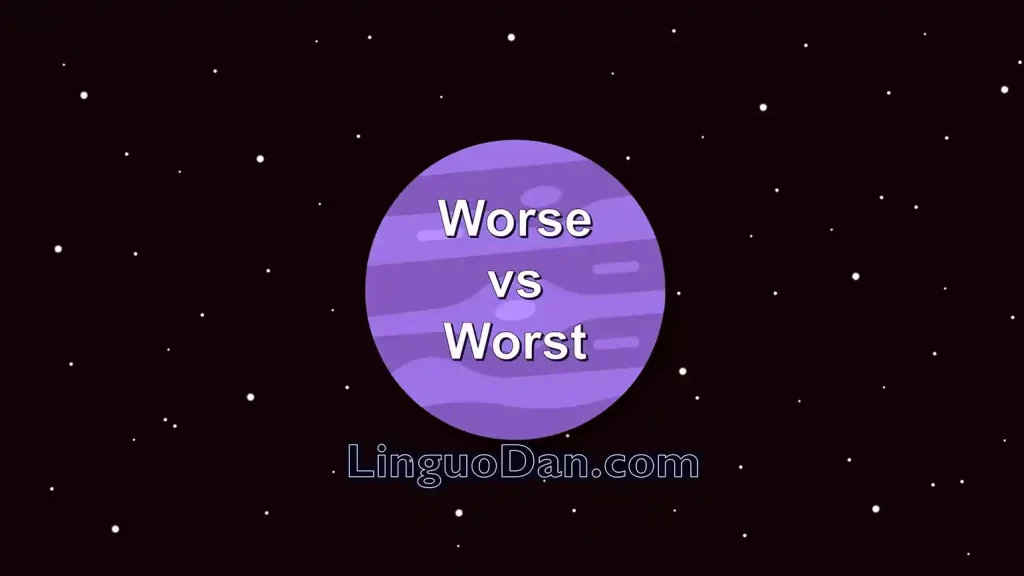Worse vs Worst: Master the Difference With Examples

Worse vs Worst: Unraveling the Crucial Difference with Practical Examples
Understanding the difference between “worse” and “worst” is crucial to clear and grammatically correct English. Although these two terms may look similar, they have different meanings and serve different purposes.
To understand the main difference between “worse” and “worst”, you need to remember the degrees of comparison of adjectives and adverbs. Most descriptive adjectives and adverbs of action and time in English form three degrees of comparison: ordinary (positive), higher (or comparative) and highest. You can read more about this in the article – The Adjective. Now consider the adjective “bad”. In this case, “bad” refers to exceptions.
Table with degrees of comparison for the word – “bad”
| ORDINARY DEGREE | HIGHER DEGREE | HIGHEST DEGREE |
| bad | worse | worst |
In this article, we’ll explore the difference between “worse” and “worst” and provide examples to help you understand how to use them correctly.
When is “Worse” used?
Let’s begin by examining “worse.” This word is the comparative form of the adjective “bad.” It is used to compare two individuals, objects, situations, or any other entities. The key point to remember is that “worse” is exclusively employed when making comparisons between just two things.
Examples illustrating the use of “worse” for comparing two things:
- I did worse on this exam than the previous one.
- His illness seems worse today than yesterday.
- The weather is worse in winter than in summer.
In each of these examples, “worse” is employed to draw a comparison between two entities, signifying that one is of a lesser quality or more unfavorable condition than the other.
When is “Worst” used?
Now, let’s explore “worst.” This word is the superlative form of “bad.” It comes into play when comparing three or more individuals, objects, situations, or any other entities. “Worst” indicates the lowest or most extreme example within a group.
Examples showcasing the use of “worst” for comparing multiple things:
- This is the worst typhoon we’ve had in decades.
- Out of all the countries, this one has the worst poverty levels.
- He is the worst performer on the team this season.
In these sentences, “worst” is employed to convey that something is the least favorable or exhibits the poorest quality when compared to a group of options.
Why it’s important to understand the difference between Worse and Worst
Understanding the difference between “worse” and “worst” is important not only for effective communication but also for maintaining proper grammar. Here’s why it matters:
- Grammar Rules: Knowing when to use “worse” and “worst” correctly is essential for adhering to English grammar rules.
- Avoiding Misunderstandings: Proper usage prevents misunderstandings and ensures clarity in your communication.
- Enhancing Writing Skills: Proficiency in distinguishing between “worse” and “worst” contributes to improving your writing skills.
Remember these key points:
- “Worse” is always paired with “than” when making comparisons between two things.
- “Worst” does not use “than.” It is reserved for comparisons involving three or more things.
- Using “worst” to compare only two things is incorrect; “worse” should be used instead.
Quiz
Let’s put your understanding to the test! Select the correct term to fill in the blanks:
- This year’s drought is _______ than last year’s. (Worse)
- Out of all my albums, this new one performed _______. (Worst)
- Her condition seems to be getting _______ every day. (Worse)
- This was the _______ storm our town has ever seen. (Worst)
To summarize:
- “Worse” is used when comparing two things.
- “Worst” is used when comparing more than two things and indicating the lowest quality or most unfavorable condition among all options.
Remember that both “worse” and “worst” are comparative and superlative forms of “bad.” So, whether you’re discussing the performance of different employees, comparing the taste of two dishes, or evaluating various movies, understanding the distinction between these two words is crucial for effective communication in English.
In conclusion, mastering the usage of “worse” and “worst” is a valuable step in improving your English language skills. By paying attention to the number of things being compared and their relative qualities, you can confidently choose the appropriate word to convey your message accurately. Keep practicing, and over time, you’ll become more comfortable with these nuances in English grammar.